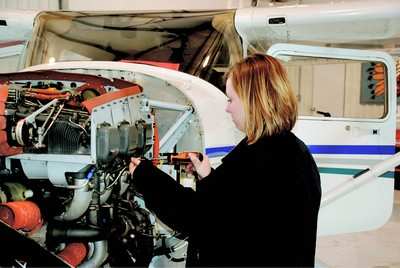Agency Says Pilots Should Work With Mechanics And Be Actively Involved In The Process
The FAA and general aviation (GA) groups’ #FlySafe national safety campaign aims to educate the GA community on best practices in calculating and predicting aircraft performance, and in operating within established aircraft limitations.

Remember the lyric, “Get your motor runnin’…”? Well, it’s even more important to KEEP your motor running. The General Aviation Joint Steering Committee (GAJSC) says inadequate engine maintenance has led to a high number of engine failures. This is not a good scenario when you are in flight.
Ideally, pilots and mechanics should work together to make sure the aircraft is operated and maintained properly. As a pilot, you should take an active role in maintenance by reviewing inspection results and discussing Airworthiness Directives and Service Bulletins with your mechanic.
- Be sure to comply with all manufacturer-recommended service intervals:
- Fifty-hour oil changes are recommended for most normally-aspirated piston engines.
- Turbo-charged engines should undergo oil changes more frequently.
- Oil filter inspection with each oil change will yield immediate feedback.
- Investigate further if you find metal particulates in the filter.
- Oil analysis can reveal a lot about engine health, but it works best when several samples create a trend.
- It’s not a bad idea to do a compression check as well as to check magneto timing, spark plugs and the exhaust system every other oil change.
Every service interval is an opportunity to give your aircraft a once-over. Look for leaks and stains in the engine compartment. Look for missing, loose, or broken hardware. Check the condition of hoses, belts, and baffles. Tires, brakes, and oleo struts should be checked as well.
How we operate our engines has a lot to do with how long they’ll last. It’s actually harder on an engine if the airplane spends a lot of time sitting in a hangar, or worse, on the ramp. Regular operation keeps your engine components lubricated, which reduces potential corrosion.
Thermal shock can be very hard on engines, so be sure your engine has reached operating temperature before you take off.
Smooth, steady power changes are good for engine longevity. This is especially true for turbo-charged powerplants. Be sure to strictly follow manufacturers’ recommendations if you are operating on the lean side of peak Exhaust Gas Temperature. It’s not worth it to save a gallon or so per hour if your engine overheats in the process.
Especially for turbos: Plan your descents with some power to keep your engine warm.
It’s true that most GA aircraft don’t have dedicated automatic flight data recording devices now, but there are still quite a few options available:
- Turbine operators are accustomed to manually recording engine cycle and performance information for trend and engine health analysis.
- You can also track engine power, fuel flow, oil temperature and pressure.
- Panel-mounted GPS systems and many hand-held units are already capable of recording position, heading, speed and altitude.
- Some engine monitors have recording capability, and many aircraft owners participate in oil analysis programs – a tool for gauging engine health and heading off expensive or disastrous problems.
- Some aircraft are equipped with metallic chip detectors that can forecast engine and transmission failures, giving you the time you need to make a safe landing.
- Basic instrumentation such as airspeed indicators, attitude indicators, angle of attack indicators, manifold pressure gauges, RPM gauges, and G-force meters all give immediate feedback as to whether design limitations have or are about to be exceeded. This information is available now, on every flight.
A Loss of Control (LOC) accident involves an unintended departure of an aircraft from controlled flight. LOC can happen because the aircraft enters a flight regime that is outside its normal flight envelope and may quickly develop into a stall or spin. It can introduce an element of surprise for the pilot.
Contributing factors may include:
- Poor judgment/aeronautical decision making.
- Failure to recognize an aerodynamic stall or spin and execute corrective action.
- Intentional failure to comply with regulations.
- Failure to maintain airspeed.
- Failure to follow procedure.
- Pilot inexperience and proficiency.
- Use of prescription, over-the-counter, or illegal drugs or alcohol.
"The FAA and industry are working together to prevent Loss of Control accidents and save lives. You can help make a difference by joining our Fly Safe campaign," said FAA Deputy Administrator Mike Whitaker. "Each month on FAA.gov, we’re providing pilots with a Loss of Control solution developed by a team of experts. They have studied the data and developed solutions – some of which are already reducing risk. We hope you will join us in this effort and spread the word. Follow #FlySafe on Twitter, Facebook and Instagram. I know that we can reduce these accidents by working together as a community."
(Source: FAA)
 NTSB Final Report: Rutan Long-EZ
NTSB Final Report: Rutan Long-EZ ANN FAQ: Turn On Post Notifications
ANN FAQ: Turn On Post Notifications Classic Aero-TV: ICAS Perspectives - Advice for New Air Show Performers
Classic Aero-TV: ICAS Perspectives - Advice for New Air Show Performers ANN's Daily Aero-Linx (06.28.25)
ANN's Daily Aero-Linx (06.28.25) Aero-News: Quote of the Day (06.28.25)
Aero-News: Quote of the Day (06.28.25)



